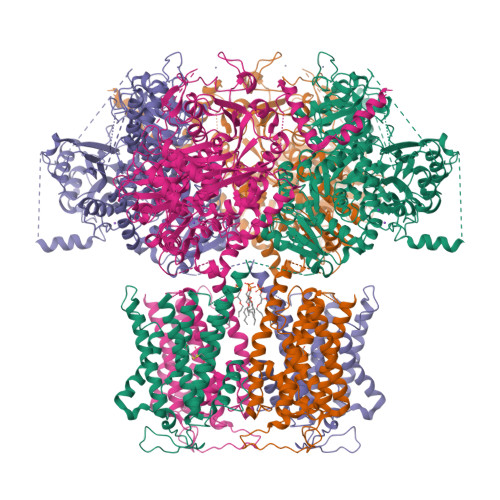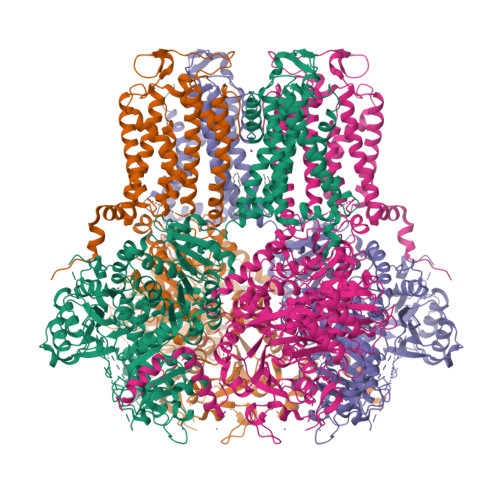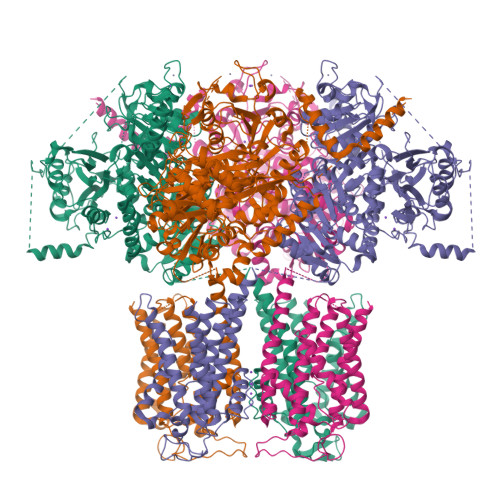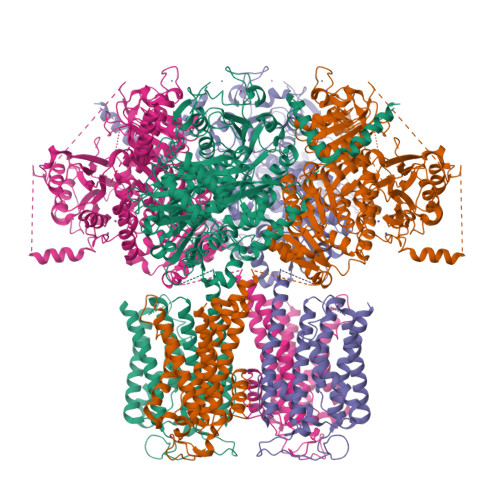
Top ▲

GtoPdb is requesting financial support from commercial users. Please see our sustainability page for more information.
Target not currently curated in GtoImmuPdb
Target id: 385
Nomenclature: KNa1.1
Family: Calcium- and sodium-activated potassium channels (KCa, KNa)
Gene and Protein Information  |
|||||||
| Species | TM | P Loops | AA | Chromosomal Location | Gene Symbol | Gene Name | Reference |
| Human | 6 | 0 | 1230 | 9q34.3 | KCNT1 | potassium sodium-activated channel subfamily T member 1 | 41 |
| Mouse | 6 | 0 | 1224 | 2 A3 | Kcnt1 | potassium channel, subfamily T, member 1 | 33,36,41 |
| Rat | 6 | 0 | 1237 | 3p13 | Kcnt1 | potassium sodium-activated channel subfamily T member 1 | 17,23 |
Previous and Unofficial Names  |
| Slo2.2 | KCa4.1 | Slack | potassium channel, sodium activated subfamily T, member 1 | potassium channel, sodium-activated subfamily T, member 1 | potassium channel |
Database Links  |
|
| Alphafold | Q5JUK3 (Hs), Q6ZPR4 (Mm), Q9Z258 (Rn) |
| ChEMBL Target | CHEMBL4739688 (Hs), CHEMBL4739694 (Mm), CHEMBL4739708 (Rn) |
| Ensembl Gene | ENSG00000107147 (Hs), ENSMUSG00000058740 (Mm), ENSRNOG00000017283 (Rn) |
| Entrez Gene | 57582 (Hs), 227632 (Mm), 60444 (Rn) |
| Human Protein Atlas | ENSG00000107147 (Hs) |
| KEGG Gene | hsa:57582 (Hs), mmu:227632 (Mm), rno:60444 (Rn) |
| OMIM | 608167 (Hs) |
| Orphanet | ORPHA317382 (Hs) |
| Pharos | Q5JUK3 (Hs) |
| RefSeq Nucleotide | NM_020822 (Hs), NM_175462 (Mm), NM_021853 (Rn) |
| RefSeq Protein | NP_065873 (Hs), NP_780671 (Mm), NP_068625 (Rn) |
| UniProtKB | Q5JUK3 (Hs), Q6ZPR4 (Mm), Q9Z258 (Rn) |
| Wikipedia | KCNT1 (Hs) |
Selected 3D Structures  |
|||||||||||

|
|
||||||||||

|
|
||||||||||

|
|
||||||||||

|
|
||||||||||

|
|
||||||||||

|
|
||||||||||
Associated Proteins  |
||||||||||||||||||||||||||
|
|
|
||||||||||||||||||||||||
| Associated Protein Comments | ||||||||||||||||||||||||||
| The Slack-B isoform of KNa1.1 forms tetramers with KNa1.2. FMRP enhances channel opening. TMEM16C modulates KNa1.2 currents and expression levels. |
||||||||||||||||||||||||||
Functional Characteristics  |
|
| KNa | |
Ion Selectivity and Conductance  |
||||||
|
||||||
|
||||||
|
||||||
|
||||||
|
| Voltage Dependence Comments |
| Experiment in Xenopus ooctyes showed weak voltage-sensitivity [45] |
Download all structure-activity data for this target as a CSV file 
| Activators | |||||||||||||||||||||||||||||||||||||||||||||||||||||||||||||||||||||||||||||||||||||||||||||||||||||||||||||||||||||||||||||||||||||||||||||||||||||||||||||||||||||||||||||||||||||||||||||||||||||||||||||||||||||||||||||||||||||||||||||
| Key to terms and symbols | View all chemical structures | Click column headers to sort | |||||||||||||||||||||||||||||||||||||||||||||||||||||||||||||||||||||||||||||||||||||||||||||||||||||||||||||||||||||||||||||||||||||||||||||||||||||||||||||||||||||||||||||||||||||||||||||||||||||||||||||||||||||||||||||||||||||||||||
|
|||||||||||||||||||||||||||||||||||||||||||||||||||||||||||||||||||||||||||||||||||||||||||||||||||||||||||||||||||||||||||||||||||||||||||||||||||||||||||||||||||||||||||||||||||||||||||||||||||||||||||||||||||||||||||||||||||||||||||||
| View species-specific activator tables | |||||||||||||||||||||||||||||||||||||||||||||||||||||||||||||||||||||||||||||||||||||||||||||||||||||||||||||||||||||||||||||||||||||||||||||||||||||||||||||||||||||||||||||||||||||||||||||||||||||||||||||||||||||||||||||||||||||||||||||
| Activator Comments | |||||||||||||||||||||||||||||||||||||||||||||||||||||||||||||||||||||||||||||||||||||||||||||||||||||||||||||||||||||||||||||||||||||||||||||||||||||||||||||||||||||||||||||||||||||||||||||||||||||||||||||||||||||||||||||||||||||||||||||
| Cytoplasmic Na+ works synergistically with Cl- for activation | |||||||||||||||||||||||||||||||||||||||||||||||||||||||||||||||||||||||||||||||||||||||||||||||||||||||||||||||||||||||||||||||||||||||||||||||||||||||||||||||||||||||||||||||||||||||||||||||||||||||||||||||||||||||||||||||||||||||||||||
Gating inhibitors 
|
|||||||||||||||||||||||||||||||||||||||||||||||||||||||||||||||||||||||||||||||||||||||||||||||||||||||||||||||||||||||||||||||||
| Key to terms and symbols | View all chemical structures | Click column headers to sort | |||||||||||||||||||||||||||||||||||||||||||||||||||||||||||||||||||||||||||||||||||||||||||||||||||||||||||||||||||||||||||||||
|
|||||||||||||||||||||||||||||||||||||||||||||||||||||||||||||||||||||||||||||||||||||||||||||||||||||||||||||||||||||||||||||||||
| View species-specific gating inhibitor tables | |||||||||||||||||||||||||||||||||||||||||||||||||||||||||||||||||||||||||||||||||||||||||||||||||||||||||||||||||||||||||||||||||
| Channel Blockers | |||||||||||||||||||||||||||||||||||||||||||||||||||||||||||||||||||||||||||||||||||||||||||||||||||||||||||||||||||||||||||||||||||||||||||||||||||||||||||||||||||||||||||||||||||||||||||||||||||||||||||||||||||||||||||||||||||||||||||||||||||||||||||||||||||||||||||||||||||||||||||||||||||||||||||||
| Key to terms and symbols | View all chemical structures | Click column headers to sort | |||||||||||||||||||||||||||||||||||||||||||||||||||||||||||||||||||||||||||||||||||||||||||||||||||||||||||||||||||||||||||||||||||||||||||||||||||||||||||||||||||||||||||||||||||||||||||||||||||||||||||||||||||||||||||||||||||||||||||||||||||||||||||||||||||||||||||||||||||||||||||||||||||||||||||
|
|||||||||||||||||||||||||||||||||||||||||||||||||||||||||||||||||||||||||||||||||||||||||||||||||||||||||||||||||||||||||||||||||||||||||||||||||||||||||||||||||||||||||||||||||||||||||||||||||||||||||||||||||||||||||||||||||||||||||||||||||||||||||||||||||||||||||||||||||||||||||||||||||||||||||||||
| View species-specific channel blocker tables | |||||||||||||||||||||||||||||||||||||||||||||||||||||||||||||||||||||||||||||||||||||||||||||||||||||||||||||||||||||||||||||||||||||||||||||||||||||||||||||||||||||||||||||||||||||||||||||||||||||||||||||||||||||||||||||||||||||||||||||||||||||||||||||||||||||||||||||||||||||||||||||||||||||||||||||
Tissue Distribution 
|
||||||||
|
||||||||
|
||||||||
|
Physiological Functions 
|
||||||||
|
||||||||
|
||||||||
|
||||||||
|
||||||||
|
||||||||
|
||||||||
|
Clinically-Relevant Mutations and Pathophysiology 
|
||||||||||||||||
|
||||||||||||||||
|
||||||||||||||||
|
||||||||||||||||
| Clinically-Relevant Mutations and Pathophysiology Comments | ||||||||||||||||
| Additional mutations and information on alterations in KCNT1 function produced by these mutations have been reported [27]. | ||||||||||||||||
| General Comments |
| KCNT1 and KCNT2 likely encode native KNa channels [1,14,24,45]. Native KNa channels were first recorded from guinea pig cardiac myocytes [25], then later found widely in neurons in the vertebrate central nervous system [15-16,19,28,34,39,43] and dorsal root ganglia [7]. KNa channels have been proposed to protect against hypoxic insult [25], but this and other possible functions remain to be clearly established. Interestingly, C. elegans slo-2 loss-of-function mutants are hypersensitive to hypoxic death [45]. Human mutations in KNa1.1 (KNCT1) give rise to a least three different types of early onset epileptic encephalopathy, each of which has devastating effects on intellectual function [26]. All of the human channel mutations that have been investigated thus far have been found to be associated with several-fold increases in KNa current [2,27,31-32]. The increases in current appear to be caused in major part by enhanced cooperative interactions between individual channels in a cluster [27]. The structure of KNa1.1 channels in the closed state has been resolved by cryo-electron microscopy [20]. |
1. Anderson NJ, Slough S, Watson WP. (2006) In vivo characterisation of the small-conductance KCa (SK) channel activator 1-ethyl-2-benzimidazolinone (1-EBIO) as a potential anticonvulsant. Eur J Pharmacol, 546 (1-3): 48-53. [PMID:16925994]
2. Barcia G, Fleming MR, Deligniere A, Gazula VR, Brown MR, Langouet M, Chen H, Kronengold J, Abhyankar A, Cilio R et al.. (2012) De novo gain-of-function KCNT1 channel mutations cause malignant migrating partial seizures of infancy. Nat Genet, 44 (11): 1255-9. [PMID:23086397]
3. Bausch AE, Dieter R, Nann Y, Hausmann M, Meyerdierks N, Kaczmarek LK, Ruth P, Lukowski R. (2015) The sodium-activated potassium channel Slack is required for optimal cognitive flexibility in mice. Learn Mem, 22 (7): 323-35. [PMID:26077685]
4. Bhattacharjee A, Gan L, Kaczmarek LK. (2002) Localization of the Slack potassium channel in the rat central nervous system. J Comp Neurol, 454 (3): 241-54. [PMID:12442315]
5. Bhattacharjee A, Joiner WJ, Wu M, Yang Y, Sigworth FJ, Kaczmarek LK. (2003) Slick (Slo2.1), a rapidly-gating sodium-activated potassium channel inhibited by ATP. J Neurosci, 23 (37): 11681-91. [PMID:14684870]
6. Bhattacharjee A, Kaczmarek LK. (2005) For K+ channels, Na+ is the new Ca2+. Trends Neurosci, 28 (8): 422-8. [PMID:15979166]
7. Bischoff U, Vogel W, Safronov BV. (1998) Na+-activated K+ channels in small dorsal root ganglion neurones of rat. J Physiol (Lond.), 510 ( Pt 3): 743-54. [PMID:9660890]
8. Biton B, Sethuramanujam S, Picchione KE, Bhattacharjee A, Khessibi N, Chesney F, Lanneau C, Curet O, Avenet P. (2012) The antipsychotic drug loxapine is an opener of the sodium-activated potassium channel slack (Slo2.2). J Pharmacol Exp Ther, 340 (3): 706-15. [PMID:22171093]
9. Brown MR, Kronengold J, Gazula VR, Chen Y, Strumbos JG, Sigworth FJ, Navaratnam D, Kaczmarek LK. (2010) Fragile X mental retardation protein controls gating of the sodium-activated potassium channel Slack. Nat Neurosci, 13 (7): 819-21. [PMID:20512134]
10. Brown MR, Kronengold J, Gazula VR, Spilianakis CG, Flavell RA, von Hehn CA, Bhattacharjee A, Kaczmarek LK. (2008) Amino-termini isoforms of the Slack K+ channel, regulated by alternative promoters, differentially modulate rhythmic firing and adaptation. J Physiol (Lond.), 586 (21): 5161-79. [PMID:18787033]
11. Budelli G, Hage TA, Wei A, Rojas P, Jong YJ, O'Malley K, Salkoff L. (2009) Na+-activated K+ channels express a large delayed outward current in neurons during normal physiology. Nat Neurosci, 12 (6): 745-50. [PMID:19412167]
12. Chen H, Kronengold J, Yan Y, Gazula VR, Brown MR, Ma L, Ferreira G, Yang Y, Bhattacharjee A, Sigworth FJ et al.. (2009) The N-terminal domain of Slack determines the formation and trafficking of Slick/Slack heteromeric sodium-activated potassium channels. J Neurosci, 29 (17): 5654-65. [PMID:19403831]
13. de Los Angeles Tejada M, Stolpe K, Meinild AK, Klaerke DA. (2012) Clofilium inhibits Slick and Slack potassium channels. Biologics, 6: 465-70. [PMID:23271893]
14. Dryer SE. (2003) Molecular identification of the Na+-activated K+ channel. Neuron, 37 (5): 727-8. [PMID:12628162]
15. Egan TM, Dagan D, Kupper J, Levitan IB. (1992) Na(+)-activated K+ channels are widely distributed in rat CNS and in Xenopus oocytes. Brain Res, 584 (1-2): 319-21. [PMID:1515948]
16. Egan TM, Dagan D, Kupper J, Levitan IB. (1992) Properties and rundown of sodium-activated potassium channels in rat olfactory bulb neurons. J Neurosci, 12 (5): 1964-76. [PMID:1578280]
17. Gibbs RA, Weinstock GM, Metzker ML, Muzny DM, Sodergren EJ, Scherer S, Scott G, Steffen D, Worley KC, Burch PE et al.. (2004) Genome sequence of the Brown Norway rat yields insights into mammalian evolution. Nature, 428 (6982): 493-521. [PMID:15057822]
18. Griffin AM, Kahlig KM, Hatch RJ, Hughes ZA, Chapman ML, Antonio B, Marron BE, Wittmann M, Martinez-Botella G. (2021) Discovery of the First Orally Available, Selective KNa1.1 Inhibitor: In Vitro and In Vivo Activity of an Oxadiazole Series. ACS Med Chem Lett, 12 (4): 593-602. [PMID:33859800]
19. Hess D, Nanou E, El Manira A. (2007) Characterization of Na+-activated K+ currents in larval lamprey spinal cord neurons. J Neurophysiol, 97 (5): 3484-93. [PMID:17329626]
20. Hite RK, Yuan P, Li Z, Hsuing Y, Walz T, MacKinnon R. (2015) Cryo-electron microscopy structure of the Slo2.2 Na(+)-activated K(+) channel. Nature, 527 (7577): 198-203. [PMID:26436452]
21. Huang F, Wang X, Ostertag EM, Nuwal T, Huang B, Jan YN, Basbaum AI, Jan LY. (2013) TMEM16C facilitates Na(+)-activated K+ currents in rat sensory neurons and regulates pain processing. Nat Neurosci, 16 (9): 1284-90. [PMID:23872594]
22. Iraci N, Carotenuto L, Ciaglia T, Belperio G, Di Matteo F, Mosca I, Carleo G, Giovanna Basilicata M, Ambrosino P, Turcio R et al.. (2024) In Silico Assisted Identification, Synthesis, and In Vitro Pharmacological Characterization of Potent and Selective Blockers of the Epilepsy-Associated KCNT1 Channel. J Med Chem, 67 (11): 9124-9149. [PMID:38782404]
23. Joiner WJ, Tang MD, Wang LY, Dworetzky SI, Boissard CG, Gan L, Gribkoff VK, Kaczmarek LK. (1998) Formation of intermediate-conductance calcium-activated potassium channels by interaction of Slack and Slo subunits. Nat Neurosci, 1 (6): 462-9. [PMID:10196543]
24. Kaczmarek LK. (2013) Slack, Slick and Sodium-Activated Potassium Channels. ISRN Neurosci, 2013 (2013). [PMID:24319675]
25. Kameyama M, Kakei M, Sato R, Shibasaki T, Matsuda H, Irisawa H. (1984) Intracellular Na+ activates a K+ channel in mammalian cardiac cells. Nature, 309 (5966): 354-6. [PMID:6328309]
26. Kim GE, Kaczmarek LK. (2014) Emerging role of the KCNT1 Slack channel in intellectual disability. Front Cell Neurosci, 8: 209. [PMID:25120433]
27. Kim GE, Kronengold J, Barcia G, Quraishi IH, Martin HC, Blair E, Taylor JC, Dulac O, Colleaux L, Nabbout R et al.. (2014) Human slack potassium channel mutations increase positive cooperativity between individual channels. Cell Rep, 9 (5): 1661-72. [PMID:25482562]
28. Koh DS, Jonas P, Vogel W. (1994) Na(+)-activated K+ channels localized in the nodal region of myelinated axons of Xenopus. J Physiol (Lond.), 479 ( Pt 2): 183-97. [PMID:7799220]
29. Lu R, Bausch AE, Kallenborn-Gerhardt W, Stoetzer C, Debruin N, Ruth P, Geisslinger G, Leffler A, Lukowski R, Schmidtko A. (2015) Slack channels expressed in sensory neurons control neuropathic pain in mice. J Neurosci, 35 (3): 1125-35. [PMID:25609627]
30. Lu S, Das P, Fadool DA, Kaczmarek LK. (2010) The slack sodium-activated potassium channel provides a major outward current in olfactory neurons of Kv1.3-/- super-smeller mice. J Neurophysiol, 103 (6): 3311-9. [PMID:20393063]
31. Martin HC, Kim GE, Pagnamenta AT, Murakami Y, Carvill GL, Meyer E, Copley RR, Rimmer A, Barcia G, Fleming MR et al.. (2014) Clinical whole-genome sequencing in severe early-onset epilepsy reveals new genes and improves molecular diagnosis. Hum Mol Genet, 23 (12): 3200-11. [PMID:24463883]
32. Milligan CJ, Li M, Gazina EV, Heron SE, Nair U, Trager C, Reid CA, Venkat A, Younkin DP, Dlugos DJ et al.. (2014) KCNT1 gain of function in 2 epilepsy phenotypes is reversed by quinidine. Ann Neurol, 75 (4): 581-90. [PMID:24591078]
33. Mouse Genome Sequencing Consortium, Waterston RH, Lindblad-Toh K, Birney E, Rogers J, Abril JF, Agarwal P, Agarwala R, Ainscough R, Alexandersson M et al.. (2002) Initial sequencing and comparative analysis of the mouse genome. Nature, 420 (6915): 520-62. [PMID:12466850]
34. Nanou E, El Manira A. (2007) A postsynaptic negative feedback mediated by coupling between AMPA receptors and Na+-activated K+ channels in spinal cord neurones. Eur J Neurosci, 25 (2): 445-50. [PMID:17284185]
35. Nuwer MO, Picchione KE, Bhattacharjee A. (2010) PKA-induced internalization of slack KNa channels produces dorsal root ganglion neuron hyperexcitability. J Neurosci, 30 (42): 14165-72. [PMID:20962237]
36. Okazaki N, Kikuno R, Ohara R, Inamoto S, Koseki H, Hiraoka S, Saga Y, Nagase T, Ohara O, Koga H. (2003) Prediction of the coding sequences of mouse homologues of KIAA gene: III. the complete nucleotide sequences of 500 mouse KIAA-homologous cDNAs identified by screening of terminal sequences of cDNA clones randomly sampled from size-fractionated libraries. DNA Res, 10 (4): 167-80. [PMID:14621295]
37. Paulais M, Lachheb S, Teulon J. (2006) A Na+- and Cl- -activated K+ channel in the thick ascending limb of mouse kidney. J Gen Physiol, 127 (2): 205-15. [PMID:16446508]
38. Qunies AM, Spitznagel BD, Du Y, Peprah PK, Mohamed YK, Weaver CD, Emmitte KA. (2024) Structure-Activity Relationship Studies in a Series of Xanthine Inhibitors of SLACK Potassium Channels. Molecules, 29 (11). [PMID:38893312]
39. Safronov BV, Vogel W. (1996) Properties and functions of Na(+)-activated K+ channels in the soma of rat motoneurones. J Physiol (Lond.), 497 ( Pt 3): 727-34. [PMID:9003557]
40. Santi CM, Ferreira G, Yang B, Gazula VR, Butler A, Wei A, Kaczmarek LK, Salkoff L. (2006) Opposite regulation of Slick and Slack K+ channels by neuromodulators. J Neurosci, 26 (19): 5059-68. [PMID:16687497]
41. Strausberg RL, Feingold EA, Grouse LH, Derge JG, Klausner RD, Collins FS, Wagner L, Shenmen CM, Schuler GD, Altschul SF et al.. (2002) Generation and initial analysis of more than 15,000 full-length human and mouse cDNA sequences. Proc Natl Acad Sci USA, 99 (26): 16899-903. [PMID:12477932]
42. Uchino S, Wada H, Honda S, Hirasawa T, Yanai S, Nakamura Y, Ondo Y, Kohsaka S. (2003) Slo2 sodium-activated K+ channels bind to the PDZ domain of PSD-95. Biochem Biophys Res Commun, 310 (4): 1140-7. [PMID:14559234]
43. Yang B, Desai R, Kaczmarek LK. (2007) Slack and Slick K(Na) channels regulate the accuracy of timing of auditory neurons. J Neurosci, 27 (10): 2617-27. [PMID:17344399]
44. Yang B, Gribkoff VK, Pan J, Damagnez V, Dworetzky SI, Boissard CG, Bhattacharjee A, Yan Y, Sigworth FJ, Kaczmarek LK. (2006) Pharmacological activation and inhibition of Slack (Slo2.2) channels. Neuropharmacology, 51 (4): 896-906. [PMID:16876206]
45. Yuan A, Santi CM, Wei A, Wang ZW, Pollak K, Nonet M, Kaczmarek L, Crowder CM, Salkoff L. (2003) The sodium-activated potassium channel is encoded by a member of the Slo gene family. Neuron, 37 (5): 765-73. [PMID:12628167]
46. Zhang J, Liu S, Fan J, Yan R, Huang B, Zhou F, Yuan T, Gong J, Huang Z, Jiang D. (2023) Structural basis of human Slo2.2 channel gating and modulation. Cell Rep, 42 (8): 112858. [PMID:37494189]
47. Zhang Y, Brown MR, Hyland C, Chen Y, Kronengold J, Fleming MR, Kohn AB, Moroz LL, Kaczmarek LK. (2012) Regulation of neuronal excitability by interaction of fragile X mental retardation protein with slack potassium channels. J Neurosci, 32 (44): 15318-27. [PMID:23115170]